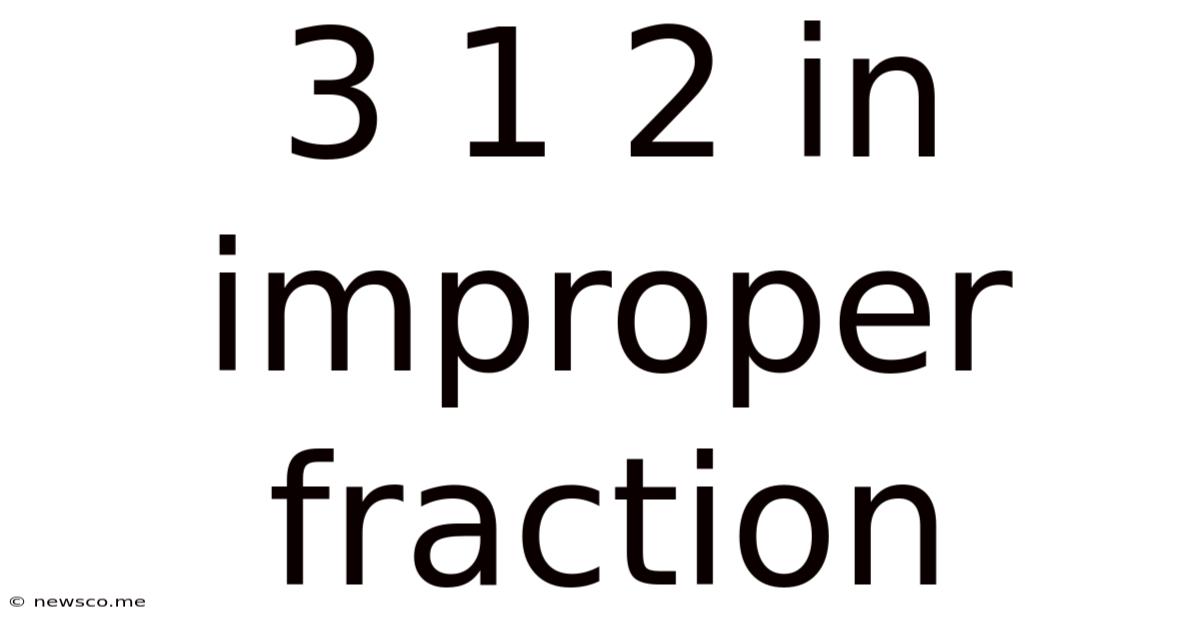3 1 2 In Improper Fraction
News Co
Mar 28, 2025 · 5 min read

Table of Contents
Understanding and Converting 3 1/2 to an Improper Fraction
The concept of improper fractions might seem daunting at first, but with a clear understanding of the underlying principles, converting mixed numbers like 3 1/2 into improper fractions becomes straightforward. This comprehensive guide will delve into the intricacies of this conversion process, providing you with a solid foundation and various methods to tackle similar problems. We'll also explore real-world applications and practical examples to solidify your grasp on this fundamental mathematical concept.
What is an Improper Fraction?
Before we dive into the conversion, let's define what an improper fraction is. An improper fraction is a fraction where the numerator (the top number) is greater than or equal to the denominator (the bottom number). For instance, 7/4, 5/5, and 9/2 are all improper fractions. They represent a value greater than or equal to one. In contrast, a proper fraction has a numerator smaller than the denominator (e.g., 1/4, 2/3, 3/5). A mixed number, like 3 1/2, combines a whole number and a proper fraction.
Converting 3 1/2 to an Improper Fraction: The Step-by-Step Method
The conversion of a mixed number to an improper fraction involves a simple two-step process:
Step 1: Multiply the whole number by the denominator.
In our example, 3 1/2, the whole number is 3, and the denominator is 2. Therefore, we multiply 3 * 2 = 6.
Step 2: Add the numerator to the result from Step 1.
The numerator of our mixed number is 1. We add this to the result from Step 1: 6 + 1 = 7.
Step 3: Keep the same denominator.
The denominator remains unchanged. In this case, the denominator stays as 2.
Therefore, the improper fraction equivalent of 3 1/2 is 7/2.
Visualizing the Conversion: A Practical Approach
Understanding the concept visually can significantly aid comprehension. Imagine you have three and a half pizzas. Each pizza is divided into two equal slices. You have three whole pizzas, each with two slices, totaling six slices (3 pizzas * 2 slices/pizza). Plus, you have an additional half-pizza, which is one more slice. In total, you have seven slices, each representing one-half of a pizza. Hence, you have 7/2 pizzas.
Alternative Methods and Problem Solving Strategies
While the standard method is efficient, exploring alternative approaches can enhance your understanding and problem-solving skills. Let's consider a slightly different perspective:
Think of 3 1/2 as the sum of three wholes and one half. We can represent three wholes as 6/2 (since 6 divided by 2 equals 3). Adding this to the 1/2, we get 6/2 + 1/2 = 7/2. This reinforces the result obtained using the standard method.
Working with Larger Mixed Numbers: Extending the Method
The process remains the same regardless of the size of the mixed number. Let's try converting 5 3/4 into an improper fraction:
Step 1: 5 (whole number) * 4 (denominator) = 20
Step 2: 20 + 3 (numerator) = 23
Step 3: Keep the denominator as 4.
Therefore, 5 3/4 is equivalent to the improper fraction 23/4.
Real-World Applications of Improper Fractions
Improper fractions are not just abstract mathematical concepts; they have numerous practical applications in everyday life:
-
Cooking and Baking: Recipes often require fractional amounts of ingredients. Converting mixed numbers to improper fractions simplifies calculations when dealing with multiple recipes or scaling recipes up or down.
-
Construction and Engineering: Precision is crucial in these fields. Improper fractions are frequently used in measurements and calculations to ensure accuracy and prevent errors.
-
Finance and Accounting: Dealing with fractions of currency or shares often necessitates converting mixed numbers into improper fractions for accurate calculations.
-
Data Analysis and Statistics: When working with datasets, representing proportions or ratios using improper fractions might be more convenient for certain calculations and analysis techniques.
Troubleshooting Common Mistakes
Even with a clear understanding of the process, some common errors can occur:
-
Forgetting to add the numerator: Remember that the crucial step involves adding the numerator to the product of the whole number and the denominator.
-
Changing the denominator: The denominator remains unchanged throughout the conversion.
-
Incorrect multiplication: Double-check your multiplication of the whole number and the denominator to avoid errors in the calculation.
Practice Problems and Exercises
To solidify your understanding, let's try a few more conversion problems:
- Convert 2 2/3 to an improper fraction.
- Convert 4 1/5 to an improper fraction.
- Convert 1 7/8 to an improper fraction.
- Convert 10 3/11 to an improper fraction.
- Convert 100 1/2 to an improper fraction.
Solutions:
- 8/3
- 21/5
- 15/8
- 113/11
- 201/2
Beyond the Basics: Expanding Your Knowledge
This comprehensive guide provides a strong foundation for understanding and converting mixed numbers into improper fractions. However, to truly master this concept, explore further:
-
Converting improper fractions back to mixed numbers: This reverse process helps strengthen your understanding of the relationship between the two forms.
-
Performing operations with improper fractions: Learn to add, subtract, multiply, and divide improper fractions, significantly expanding your mathematical capabilities.
-
Working with complex fractions: Explore how these concepts extend to more complex fractions containing fractions within fractions.
By consistently practicing and exploring different applications, you will develop a deep understanding of improper fractions and their importance in various fields. Remember that consistent practice is key to mastering any mathematical concept, so keep practicing and refining your skills. This will not only improve your mathematical abilities but also enhance your problem-solving skills in various aspects of your life.
Latest Posts
Related Post
Thank you for visiting our website which covers about 3 1 2 In Improper Fraction . We hope the information provided has been useful to you. Feel free to contact us if you have any questions or need further assistance. See you next time and don't miss to bookmark.